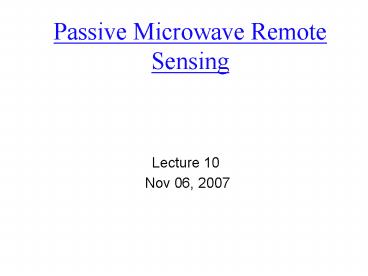Passive Microwave Remote Sensing PowerPoint PPT Presentation
1 / 30
Title: Passive Microwave Remote Sensing
1
Passive Microwave Remote Sensing
- Lecture 10
- Nov 06, 2007
2
Principals
- While dominate wavelength of Earth is 9.7 um
(thermal), a continuum of energy is emitted from
Earth to the atmosphere. In fact, the Earth
passively emits a steady stream of microwave
energy as well, though it is relatively weak in
intensity due to its long wavelength. - The spatial resolution usually low (kms) since
the weak signal. - A suit of radiometers can record it. They measure
the brightness temperature of the terrain or the
atmosphere. This is much like the thermal
infrared radiometer for temperature. - A matrix of brightness temperature values can
then be used to construct a passive microwave
image. - To measure soil moisture, precipitation, ice
water content, sea-surface temperature, snow-ice
temperature, and etc.
3
Rayleigh-Jeans approximation of Plancks law
Thermal infrared domain (Plancks law)
Microwave domain (Rayleigh-Jeans approximation)
Recall
Let
We have
We have
Unit is Wm-2Hz
4
- For a Lambertian surface, the surface brightness
radiation B(v,T), - The really useful simplification involves
emissivity and brightness temperature
Unit is Wm-2Hzsr
In comparison with thermal infrared (TB)4 e?
(T)4
5
Some important passive microwave radiometers
- Special Sensor Mirowave/Imager (SSM/I)
- It was onboard the Defense Meterorological
Satellite Program (DMSP) since 1987 - It measure the microwave brightness temperatures
of atmosphere, ocean, and terrain at 19.35,
22.23, 37, and 85.5 GHz. - TRMM microwave imager (TMI)
- It is based on SSM/I, and added one more
frequency of 10.7 GHz.
6
(No Transcript)
7
AMSR-E
- Advanced Microwave Scanning Radiometer EOS
- It observes atmospheric, land, oceanic, and
cryospheric parameters, including precipitation,
sea surface temperatures, ice concentrations,
snow water equivalent, surface wetness, wind
speed, atmospheric cloud water, and water vapor. - At the AMSR-E low-frequency channels, the
atmosphere is relatively transparent, and the
polarization and spectral characteristics of the
received microwave radiation are dominated by
emission and scattering at the Earth surface. - Over land, the emission and scattering depend
primarily on the water content of the soil, the
surface roughness and topography, the surface
temperature, and the vegetation cover. - The surface brightness T (TB ) tend to increase
with frequency due to the absorptive effects of
water in soil and vegetation that also increase
with frequency. However, as the frequency
increase, scattering effects from the surface and
vegetation also increase, acting as a factor to
reduce the TB
8
AMSR-E
Najoku et al. 2005
9
Example1 Snow depth or snow water equivalent
(SWE)
- The microwave brightness temperature emitted from
a snow cover is related to the snow mass which
can be represented by the combined snow density
and depth, or the SWE (a hydrological quantity
that is obtained from the product of snow depth
and density).
?Tb Tb19V-Tb37V
10
Kelly et al. 2003
11
3. Study Area (1)
12
Impact of snow density (4)-mean SD
Snow density 0.4 g/cm3 Multi-snow density
Xianwei, Xie, and Liang 2006
13
Results AMSR-E vs ground- SD at individual
stations (snow density 0.4 g/cm3)
14
Results AMSR-E vs ground- SD at individual
stations (snow density 0.4 g/cm3)
15
Results Annual change of SWE in YWR
16
Antarctic sea ice
17
Mike and Xie, 2006
18
Maximum SD values exceed 50-60 cm in most data
sets, (outside range of retrievable snow depth
for 37GHz) and are likely noise
Mike and Xie, 2006
19
Mike and Xie, 2006
20
(No Transcript)
21
Seasonal Comparison of Locations of Max SD Areas,
2002
Max Areas 2s
7/20/02
10/20/02
11/18/02
8/20/02
9/24/02
12/20/02
22
Seasonal Comparison of Locations of Max SD Areas,
2003
4/20/03
1/20/03
7/20/03
10/20/03
5/20/03
2/20/03
8/20/03
11/18/03
Oct 1, 2005
Oct 1, 2004
3/20/03
6/20/03
9/20/03
12/20/03
23
Seasonal Comparison of Locations of Max SD Areas,
2004
1/20/04
4/20/04
7/22/04
10/20/04
11/17/04
5/20/04
2/20/04
8/20/04
3/20/04
6/19/04
9/17/04
12/20/04
24
Seasonal Comparison of Locations of Max SD Areas,
2005
4/20/05
7/20/05
10/20/05
1/20/05
5/20/05
2/20/05
8/20/05
11/16/05
3/20/05
6/20/05
9/20/05
12/20/05
25
Example2 Radio-frequency interference
contaminate the 6.9 and 10.7 GHz channels
- Radio-frequency interference (RFI) the cable
television relay, auxiliary broadcasting, mobile.
RFI is several orders of magnitude higher than
natural thermal emissions and is often
directional and can be either continuous or
intermittent. - Radio-frequency interference (RFI) is an
increasingly serious problem for passive and
active microwave sensing of the Earth. - The 6.9 GHz contamination is mostly in USA,
Japan, and the Middle East. - The 10.7 GHz contamination is mostly in England,
Italy, and Japan - RFI contamination compromise the science
objectives of sensors that use 6.9 and 10.7 GHz
(corresponding to the C-band and X-band in active
microwave sensing) over land.
26
(No Transcript)
27
radio-frequency interference (RFI) index (RI)
28
Li et al. 2004
29
6.9 GHz contamination
Najoku et al. 2005
30
(No Transcript)

